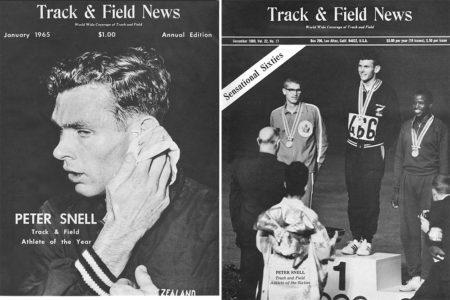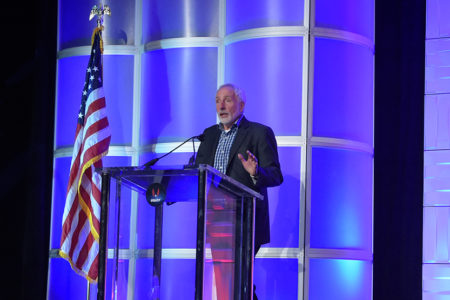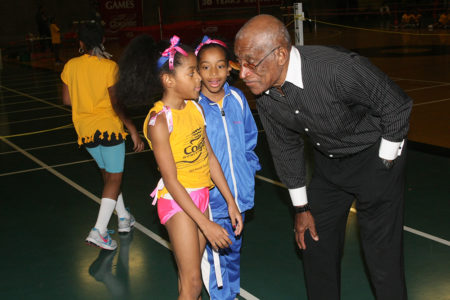
THE FIRST NORWEGIAN to be named T&FN Men’s Athlete Of The Year, Karsten Warholm is the fourth 400 hurdler to earn the honor since its debut in ’59. He is also a sportsman of sportive humor. Viz his selection as World Athletics’ AOY at WA’s annual gala in Monaco, Warholm kidded, “Seb Coe doesn’t agree. He gave it to [Eliud] Kipchoge… Let’s give that award to a shoe, that would be nice.”
More in keeping with tradition, our award goes to an athlete. In Warholm’s case one who first fully focused his efforts on the 1-lap hurdles in the Rio Olympic year, 2016, after a T&F polymath early career that carried him to the World Youth (U18) octathlon title in ’13. (Continued below)
In the conversation below Warholm explains his event switch away from the multis, which he made after joining forces with coach Leif Olav Alnes in Oslo in ’15. Today, coach and athlete form a remarkably close team, their relationship based on friendship and humor as much as shared purpose. “It’s like we’re the same age mentally—whatever age that is, whether it’s five years or 50, that’s up to you to decide,” Warholm wrote on SpikesMag.
T&FN touched base with Warholm, a superstar in his sports-mad nation of some 5.3 million, in the waning days of his AOY year.
T&FN: This was quite a year you had, needless to say. What aspect are you most happy about as the Olympic year approaches? Going undefeated? Or the unprecedented sequence of super-fast times? Or something else?
Warholm: I think for me to fully explain the meaning of this season, we need to go back one year. Because I had the 2018 season and for me after I won in London in 2017 everything about me and my results and my sports was really hyped because [Norwegian] people were thinking, “Oh, now we have a winner that we can follow for the next 10 years.” Just as we have in cross country skiing, you know? All the Norwegians do it. But actually I had a really good progression coming in to 2018, I improved from 48.22 to 47.64, which is really a lot on that level, right? It’s just under 2%.
But I got beaten, right? I got beaten by Samba and then Rai Benjamin came, he ran really, really quick times. And I felt like I probably had the best year progression-wise, but because I didn’t win everybody saw it as like, “Uh, an OK year” but not like very good, you know? This year I improved just as much and the other guys didn’t improve a lot or they got injured or whatever happened. Then I started winning again and then it’s really good.
But for me, it’s like I go to practice every day and I can feel myself becoming better each day, you know, as last year. What people see is who crosses the finish line first. But for me it’s like I’m always becoming better, always running faster times. Always do better, that is the thing that I probably valued the most. So as long as I have progression, I value that. So I’m not afraid of losing but I’m very afraid of not developing. So this year, as last year, I’m very happy with improving and becoming even better because it’s more and more difficult as you get on a higher level.
T&FN: You mentioned cross country skiing. Did you compete in that sport as a child? If so, how good were you?
Warholm: I did not, actually. I’ve been doing a lot of cross country skiing in my childhood but never in competition because I’ve always had “fast muscles,” if you know what I mean. I don’t know the English word.
T&FN: Your muscles have a lot of fast-twitch fibers. That relates to why I asked. I wondered if despite your obvious speed, you developed a youthful endurance base from ski racing that has helped you in the long hurdles?
Warholm: No, it was always very tough for me to walk longer distances on skis and whatever. So I always just played soccer and I fancied running very hard for a short, short time.
T&FN: When did you start running?
Warholm: Oh, very early. I was actually visiting the city center of the small place where I’m from in Norway. It’s a place called Ulsteinvik. Then a friend of mine, he was in the track & field club and he came and asked me and said, “You need to join this race.” I was there in my jeans and this t-shirt that was way too big for me or whatever. So I joined the race and I won; I think it was 200m or something, just around a county building. That was when I started and after that I was always going to practices, I was always there and had all my friends in the track & field environment. So the rest is history, as they say.
T&FN: Surely. How old were you at that time?
Warholm: Oh, I think I was about 8 years old maybe. I’m not 100% sure but around 8.
T&FN: You had quite a distinguished career as a young multis athlete. You were the World Youth octathlon champion at 17 back in 2013. How did you progress from racing around a building at age 8 to the extremely organized training needed to achieve at that level?
Warholm: The thing was I was really good in all short running up to 400m and all the jumping. So in the national Junior championships I always did 8 events and a lot of times I also got 8 gold medals. So I liked everything. One year I was best in long jump, one year I was best in 110m hurdles, and so on. I never got to decide what I liked the most so then I joined the octathlon for the World U18 Championships then. Eight events, that suited me perfectly. The next year it was 10 events, which included pole vault and discus, and you could say I was f****ed. Too many new things to learn and all of a sudden it was a very long way to go. And that’s also why my new [and current] coach here in Oslo said we should try 400m hurdles—because the way was too long to learn all these things because I’d never done pole vault or discus. So it was very hard.
T&FN: That’s when you started working with Leif Olav Alnes?
Warholm: Yes, in 2015.
T&FN: Did he immediately start training you for the 400 hurdles?
Warholm: Not exactly, because I was still thinking I was going to do the decathlon. But we had this short-term goal that I was going to reach the Olympics and he said, “If you want to reach the Olympics you should be in another event because the decathlon will take too long.” And I agreed on that. So we tried the 400m hurdles and when I sorted the 400m hurdles out that quick and I liked that very much, that was when I just decided that I can’t do the decathlon training anymore. I gotta go all in on this and I enjoy it. So that happened right about after the Rio Olympics.
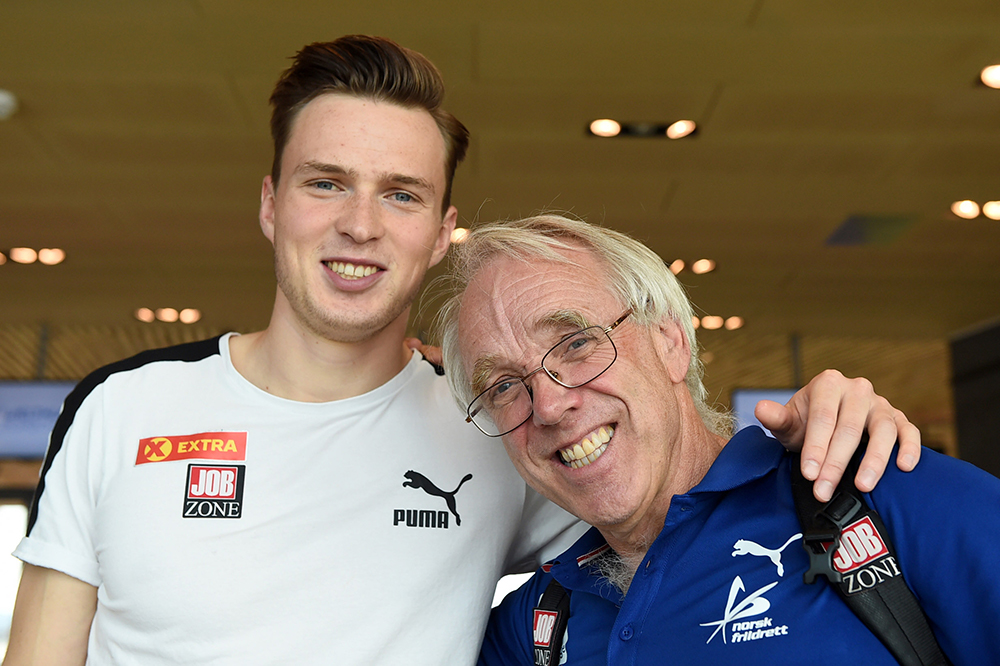
T&FN: Wow, I guess reaching the Olympic semis less than two years after your first race in the event was motivational. It’s obvious you have great communication and rapport with your coach. There’s evidence of fun and good humor between you on social media. I know that he pushes you hard in training and you fully accept that from what I’ve read. What did he have to say about the 2019 season after it was over?
Warholm: He’s been in the game for 40 years and he says that I probably don’t understand how good I did and that is a good thing because we’re going to keep on delivering. So he’s better if I can’t fully wrap my head around how good the season was. So he is very proud of the work we’ve done. It’s fun.
T&FN: You both should be proud. I’ve read that you and he place good-natured bets with each other from time to time. Have you made any coach wagers for 2020?
Warholm: We haven’t done that this year, actually. Maybe it’s bad luck, I don’t know. We should probably figure something out. But right now we’re working on still trying to teach him smart phones. He just got an iPad so I’m trying to teach him how to use that as a tool for training and filming and all those types of things. That is very hard work. You know, it’s probably more difficult to teach him how to use the iPad than for me to probably take the gold medal in Tokyo.
T&FN: I will quote you on that. Last winter you and he posted some humorous photos of you “holding him hostage” to force him to let you run the European Indoor 400. Maybe he’s glad he gave in since you won [PR 45.05]. Will you need to tie him up again over any decisions for the coming season?
Warholm: Not so far but these things can pop up when we least expect it. But this year I’m probably not going to do so much indoor so we won’t have an issue when it comes to outdoor. We have a very clear plan that we both agree on but it’s not going to include World Indoor Championships this year.
T&FN: OK. Can you say anything about how your training will progress this coming season building upon the past?
Warholm: Yeah, I feel like we’re always just trying to do some of the things that we’ve always done and that we know are working and then try to put on even more volume, even more quality. I think that we’ve managed to do that also now, but there is also a very fine line because we don’t want to get injured, right? Knock on wood, we’ve been very lucky when it comes to that. But that is also because I think we’re very smart when we approach training and everything, but we’re always trying to put on some more because the body can handle more and more over the years because I’ve been well trained. So just a little bit more and then also trying to build on the work that we’ve already done.
T&FN: To perform at the level you do, you must go through periods in training when you are quite fatigued. How does your coach make a decision that maybe it’s time to back off just a little? Do you know his thought process?
Warholm: We have an understanding that we need to be totally honest so I’m very honest about how I feel in training. He knows that I won’t say that I’m really tired unless I am. And I don’t want to be tired, you know? We trust each other and on the feedback that I give he can make the best decisions.
T&FN: Can you comment on your race pattern. Do you feel an evolution in that is a key to running even faster or is improving fitness, strength and speed more important?
Warholm: I think the last one is more important. I’ve been very caught up in all these strides and everything but this year I actually came to the conclusion that probably it’s better to just run and just pass the hurdles as they come. Because, you know, we have people that have been running really, really fast doing 13 [strides between hurdles], we have people that have been running really fast doing 14. Bershawn Jackson, if I’m not mistaken, ran 47.20 on 15 steps. So it’s all about finding the way that works for you. And I open up tougher than Kevin Young on the first 5 hurdles but he did 12 on the backstretch for two hurdles, if I’m not wrong. So it’s like there are several ways to do it. But for me the 13-step pattern works 100% for at least 8 hurdles, but the last 2 hurdles, I gotta find a way to solve it better, I think. There are several ways to do it: I can go 13 all the way, I can go 14 on 8 to 9, I can go 13 to 9 and then 15—which I did in Doha, for example.
T&FN: Oh, you went 15? I knew you didn’t alternate.
Warholm: Yeah, I did 15. So there are so many ways to do it. In Paris I did 13 all the way. In London when I ran 47.12 I did 13 to 9, then 14. And then also when I ran in Zürich I didn’t make the ninth hurdle so I did 15 for both 9 and 10. So I’ve been doing a lot of these things but all the races that I’ve been doing good, I feel like I’ve been just running. I mean just running and not thinking about my stride pattern that much, just trying to get over.
T&FN: It’s mid-December and you are training in Oslo. Will you train there through the winter or move to some warm place?
Warholm: Both, actually. We like to do the most and have the training here in Oslo. We have very nice indoor facilities and we have all the things that we need here. But we were just in Tenerife [the Canary Islands] in November, which is warm—25, 30 degrees [c75-85F]—and we can do some quality work outdoors. We’ll probably also go there in January or February. So we take a couple trips to Tenerife to train and for the rest we stay in Oslo.
T&FN: Do you have access in Tenerife to all the specific equipment and sort of higher-tech modalities you need to prepare?
Warholm: That is what I like about training. Nothing is very high-tech to be honest with you. If you come to Norway once, I’m going to show you how we train. I think you’ll be very surprised to see how “Rocky style” it is because we are mostly training in an old soccer facility where there is an old strengthening room that we made ourselves with the equipment that we got from the Norwegian Sports Center, which they were going to throw away because it was old. So we took it over there and that is the place that we work because we like it that way. You know, running is very simple. It’s built on very simple ideas, I think, and we’re just trying to make the most out of these things. And my coach is extremely good at those things.
T&FN: I’ve seen the photos of coach Alnes demonstrating running technique to you? Impressive form from a man his age.
Warholm: It’s crazy, yeah. We were just doing a dead lift here the other day. I don’t lift that much—probably dead lift is the only thing that I do—and I was struggling on 120 kilos. I don’t know how much that is in pounds [c265]. I’m not very strong but I was doing 5s and he was doing 15s and 10s, and I was like, “What is going on?!” That guy, really, he’s powerful.
T&FN: Is he a former athlete?
Warholm: Yeah, he was. He ran the 100 meters.
T&FN: OK. Amazing.
Warholm: It is.
T&FN: You’ve said that when you line up for races you like to tell yourself all the reasons you believe you deserve to win. For races like that Diamond League title race in Zürich or the World Championships, do you plan strategies based on the athletes you are facing or do you just think about your motivations and run your own race?
Warholm: I think I’m probably one of the easiest guys to know what he’s gonna do. You know, I always go out hard and try to keep it for as long as it goes. And I always do that. So for me it’s, you know, I’ll take lane 7 if I can. I want to be far out on the bend and just do my own thing because I’m not that into tactics and everything because I don’t think it will work for the 400m hurdles. You know, it’s very primitive, it’s easy, it’s going from A to B in hopefully around 46, 47 seconds. So I can’t really do that much, I just gotta go really hard. I know if I run fast enough that I’ll probably win or place good.
T&FN: I had noticed you always take lane 7 at the DL meets. That’s based on track position, not 7 as a lucky number?
Warholm: It’s not a lucky number, as you can see. I knew when I got to Doha I was going to get another lane than lane 7, but getting far out on the bend is very good when it comes to injuries, it’s not as hard of an impact as in the inner lanes. So therefore it’s just an investment in having a longer career. So I always run far out on the bend if I can.
T&FN: Are your rivalries with Samba and Benjamin friendly? When your paths cross do you converse with each other?
Warholm: Oh, yeah, the day before we ran in Zürich me and Rai were sitting down and having a very, very good conversation. Also my coach was there and it was very good. You know my training partner Amalie Iuel, she was at USC before she got to Norway training with us so she knows Rai and we know some of the same people and everything. So it’s very nice to sit down and chat. I haven’t been speaking so much to Samba. There are some language barriers, as well but we’re actually good friends, you know. We’re not best friends but we speak together in a friendly tone and I think we actually respect each other for our running and the work we do. I think that’s the way it should be.
T&FN: Absolutely. What are your impressions of those two as athletes?
Warholm: They’re obviously more talented than me [laughs]. They’re super skinny, super long, you know, natural-fast. They look like if you were to put something in a machine and they were going to build a perfect 400m hurdler, you’d get out Rai Benjamin or Samba. For me, I’m probably made for this as well but I think they are more like the same type of runner and I’m more a little bit shorter, maybe a little bit more powerful in that way, and maybe also a little bit more robust in some way. So we all have our advantages on each other and then it’s all about playing your cards the best way. [In 2018] they played a little bit better than me. This year I was lucky enough to stay injury free and then to deliver good results. So these things, they come and go, but they are very talented. You can see that all that well. I admire them for that, absolutely.
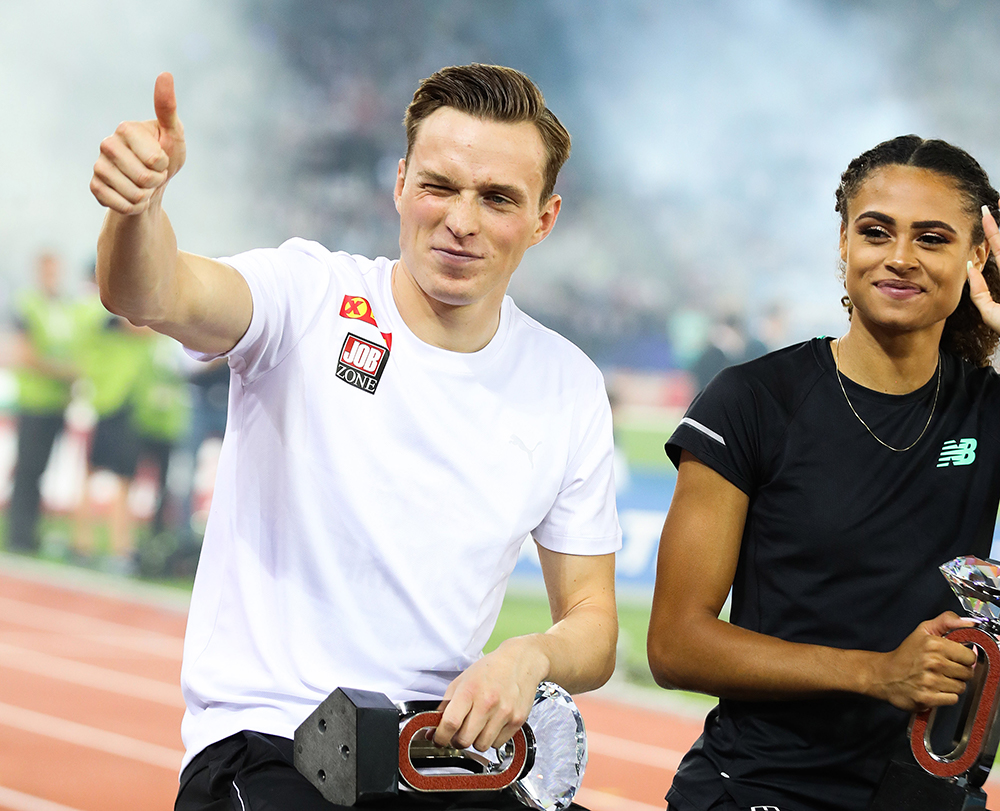
T&FN: Your marks in other events are not bad. That’s an understatement. But when you took up this event in 2015 did you imagine you would get to this level, these kinds of times?
Warholm: Oh, no, because we were that far away. I didn’t think that anybody would come in 2018 and run all of a sudden 46.98 and 47.02. I was like, “That’s crazy.” We haven’t seen that in 20, 30 years, it’s crazy. But at the same time it was like, you know, when they can do it I was thinking I can do it also. So I didn’t imagine it but I think that I had a very nice way to deal with it: If somebody else can do it, I can probably do it as well.
T&FN: Your consistency in 2019 was highly impressive. Even Edwin Moses never put up so many astoundingly fast times in a season. Moses ran each of his three fastest times—47.02, 47.13 and 47.14—in different years. You ran two PRs this season and your 5 fastest marks averaged 47.21. Unprecedented.
Warholm: That’s true. That’s a good point.
T&FN: If the World Record falls in 2020 do you think it will be In Tokyo or at a Diamond League meet?
Warholm: There are a lot more Diamond League meetings than there are Olympic finals. From the most likely point of view, it would probably be in a Diamond League if it were to fall. But you know Tokyo is the biggest stage and it’s a fast track and it’s probably warm and everything so there’d be chances of it happening in Tokyo as well. But, you know, everybody was talking about it in Doha and we were quite far from it. It’s always like you never know. I think it has better chances if everybody is not thinking it will happen. I don’t know, I’m very—what do you call it when you believe in higher powers?
T&FN: Spiritual? I think you mean there’s an undefinable extra element or dimension in the mix when World Records are achieved?
Warholm: I think there is a high chance that it will happen in 2020 but I’m not sure when or how.
T&FN: What are your thoughts on the Doha World Championships final? Rai was injured, Samba had missed most of the season with injury, but nonetheless many thought the times might be faster. Instead it was more of a pre-Olympic teaser.
Warholm: You know, I was running and I felt like I had a perfect race. I was going all out and I was looking at the clock coming home and thought, “What just happened?” I thought it was faster and it felt faster and everything, so you know, it was probably a long season, tired body and whatever. We had a fast race in Zürich so I’m not too sure what happened, I can’t explain it, but I was actually quite shocked that the time wasn’t better because the race felt perfect.
T&FN: I have to ask. Your look of positive shock after you won gold at London in 2017 was instantly compared to the face in Edvard Munch’s “The Scream.” But the visage in the painting appears to be a haunted, hunted soul. That doesn’t seem to be you. Any thoughts about that?
Warholm: You know, it was very funny because that was a very spontaneous reaction. For me, it was just funny because, at least in the athletics environment, it went viral and it was kind of funny. I have no plans to do it again as a celebration, but it’s funny and the picture describes how I felt and describes that moment. So it’s nice to have. I look at that picture and I can just feel what happened that day so it’s cool.
T&FN: Do you look at images like that for inspiration?
Warholm: Of course, of course, yeah. When I’m having a bad day I need to look back at all the things that are good and that I’m proud of in my career. So it’s a motivational booster.
T&FN: With the World Indoor Championships not on your schedule this winter, are you planning no indoor races at all?
Warholm: No, I’m hosting my own meet indoors so I’m going to do that on my birthday, the 28th of February in Ulsteinvik, my hometown. I’m doing that for the second year now. It’s going to be broadcast on Norwegian television, live, it’s cool. And for the summer it’s going to be some Diamond Leagues. Of course Bislett Games and probably a couple more. And then it’s Tokyo. There are not going to be that many meets before and I’m going to just make sure that I’m 100% prepared when the Olympics arrive.
T&FN: Final question. World Record holder Kevin Young thinks a 45-point 400 hurdles time is possible. What do you think?
Warholm: Yeah, I think it’s possible. But I need more time [laughs]. I can agree with Kevin—but it’s not going to be easy—that’s fast. But it’s going to be very interesting to follow this event in the future. I’m looking forward to being a part of it.
